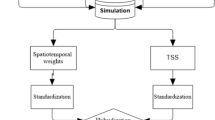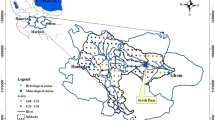Abstract
Continued global warming has increased the risk of drought all over the world. Therefore, effective drought assessment, in conjunction with accurate drought characterization and its long-term evaluation, is essential. In recent developments, the use multi-model ensemble data of various specific sets of Global Climate Models (GCMs) is common in climate research. This research provides a new drought index – Multivariate Weighted Ensemble Standardized Drought Index (MWESDI). The procedure of MWESDI uses Common Factor Analysis (CFA) based data mining approach for handling multiplicity and specificity structural problems in the data sets. The proposed procedure aims to enhance the effective use of GCMs by addressing the data problems associated with dimensionality reduction and important feature extraction. In application, we used observed and simulated time series data of 18 GCMs distributed across the Tibet Plateau region of China. Based on error performance measures, the proposed index is a more reliable and precise measure compared to its competitors. Our findings related to drought assessment indicate that the Tibet Plateau will probably face more severe and frequent droughts during the 21st Century.






Similar content being viewed by others
Data Availability
The data that support the findings of this study are available from the corresponding author upon reasonable request.
References
Aadhar S, Mishra V (2020) On the projected decline in droughts over South Asia in CMIP6 multimodel ensemble. J Geophys Res Atmos 125(20), e2020JD033587
Acharya N, Shrivastava NA, Panigrahi BK, Mohanty UC (2014) Development of an artificial neural network based multi-model ensemble to estimate the northeast monsoon rainfall over south peninsular India: an application of extreme learning machine. Clim Dyn 43(5):1303–1310
Agrawal AK, Murthy VMSR, Chattopadhyaya S (2019) Investigations into reliability, maintainability and availability of tunnel boring machine operating in mixed ground condition using Markov chains. Eng Fail Anal 105:477–489
Aksu H, Cetin M, Aksoy H, Yaldiz SG, Yildirim I, Keklik G (2022) Spatial and temporal characterization of standard duration-maximum precipitation over Black Sea Region in Turkey. Nat Hazards 111:2379–2405
Ali Z, Almanjahie IM, Hussain I, Ismail M, Faisal M (2020) A novel generalized combinative procedure for Multi-Scalar standardized drought Indices-The long average weighted joint aggregative criterion. Tellus a: Dynamic Meteorology and Oceanography 72(1):1–23
Ali Z, Ellahi A, Hussain I, Nazeer A, Qamar S, Ni G, Faisal M (2021) Reduction of errors in hydrological drought monitoring–a novel statistical framework for spatio-temporal assessment of drought. Water Resour Manage 35(13):4363–4380
Al-Zoughool M, Oraby T, Vainio H, Gasana J, Longenecker J, Al Ali W, Tyshenko MG (2022) Using a stochastic continuous-time Markov chain model to examine alternative timing and duration of the COVID-19 lockdown in Kuwait: what can be done now? Arch Public Health 80(1):22
Christensen NS, Lettenmaier DP (2007) A multimodel ensemble approach to assessment of climate change impacts on the hydrology and water resources of the Colorado River Basin. Hydrol Earth Syst Sci 11(4):1417–1434
Da Silva RM, Santos CA, Moreira M, Corte-Real J, Silva VC, Medeiros IC (2015) Rainfall and river flow trends using Mann-Kendall and Sen’s slope estimator statistical tests in the Cobres River basin. Nat Hazards 77:1205–1221
Deo RC, Kisi O, Singh VP (2017) Drought forecasting in eastern Australia using multivariate adaptive regression spline, least square support vector machine and M5Tree model. Atmos Res 184:149–175
Dikshit A, Pradhan B, & Santosh M (2022) Artificial neural networks in drought prediction in the 21st century–A scientometric analysis. Appl Soft Comput 114:108080
Elbeltagi A, Kumar M, Kushwaha NL, Pande CB, Ditthakit P, Vishwakarma DK, Subeesh A (2023) Drought indicator analysis and forecasting using data driven models: Case study in Jaisalmer, India. Stoch Env Res Risk Assess 37(1):113–131
Falloon P, Betts R (2010) Climate impacts on European agriculture and water management in the context of adaptation and mitigation—the importance of an integrated approach. Sci Total Environ 408(23):5667–5687
Feng S, Lu H, Yao T, Tang M, Yin C (2023) Analysis of microplastics in soils on the high-altitude area of the Tibetan Plateau: Multiple environmental factors. Sci Total Environ 857:159399
Gallager RG (1997) Discrete stochastic processes. Journal of the Operational Research Society 48(1):103–103
Gumus V, Avsaroglu Y, Simsek O (2022) Streamflow trends in the Tigris river basin using Mann− Kendall and innovative trend analysis methods. J Earth Syst Sci 131(1):34
Härdle WK, Simar L (2019) Applied multivariate statistical analysis. Springer Nature
Holden PB, Rebelo AJ, Wolski P, Odoulami RC, Lawal KA, Kimutai J, New MG (2022) Nature-based solutions in mountain catchments reduce impact of anthropogenic climate change on drought streamflow. Commun Earth Environ 3(1):51
Husak GJ, Michaelsen J, Funk C (2007) Use of the gamma distribution to represent monthly rainfall in Africa for drought monitoring applications. International Journal of Climatology: A Journal of the Royal Meteorological Society 27(7):935–944
Iqbal Z, Shahid S, Ahmed K, Ismail T, Khan N, Virk ZT, Johar W (2020) Evaluation of global climate models for precipitation projection in sub-Himalaya region of Pakistan. Atmos Res 245:105061
Karki JR, Kumar P, Baniya B (2022) Climate change and mountain environment in context of sustainable development goals in Nepal. Applied Ecology and Environmental Sciences 10(9):588–594
Kendall MG (1975) Rank Correlation Methods. Griffin, London, UK
Laux P, Jäckel G, Tingem RM, Kunstmann H (2010) Impact of climate change on agricultural productivity under rainfed conditions in Cameroon—A method to improve attainable crop yields by planting date adaptations. Agric for Meteorol 150(9):1258–1271
Li Z, Riaz S, Qamar S, Ali Z, Abbasi JN, Fayyaz R (2022) Development of adaptive standardized precipitation index and its application in the Tibet Plateau region. Stoch Environ Res Risk Assess 1–19
Lombardi R, Davis ML (2023) Setting the stage: How abrupt climate change, geomorphic thresholds, and drought control flood response in the lower Tennessee River, USA. Quatern Sci Rev 301:107931
Lopes H (1904) Factor models: An annotated bibliography. J Psychol 5:201–293
Mann HB (1945) Nonparametric tests against trend. Econometrica 13:245–259
McLachlan GJ, Chang SU (2004) Mixture modelling for cluster analysis. Stat Methods Med Res 13(5):347–361
Mendes MP, Rodriguez-Galiano V, Aragones D (2022) Evaluating the BFAST method to detect and characterise changing trends in water time series: A case study on the impact of droughts on the Mediterranean climate. Sci Total Environ 846:157428
Mikhaylov A, Moiseev N, Aleshin K, Burkhardt T (2020) Global climate change and greenhouse effect. Entrepreneurship and Sustainability Issues 7(4):2897
Pieper P, Düsterhus A, Baehr J (2020) A universal Standardized Precipitation Index candidate distribution functions for observations and simulations. Hydrol Earth Syst Sci 24(9):4541–4565
Salas-Páez C, Quintana-Romero L, Mendoza-González MA, Álvarez-García J (2022) Analysis of job transitions in Mexico with Markov chains in discrete time. Mathematics 10(10):1693
Salehie O, Hamed MM, Ismail TB, Tam TH, Shahid S (2022) Selection of CMIP6 GCM with projection of climate over the Amu Darya River Basin. Theor Appl Climatol 1–19
Sen PK (1968) Estimates of the regression coefficient based on Kendall’s tau. J Am Stat Assoc 63:1379–1389
Soylu Pekpostalci D, Tur R, Danandeh Mehr A, Vazifekhah Ghaffari MA, Dąbrowska D, Nourani V (2023) Drought monitoring and forecasting across Turkey: A contemporary review. Sustainability 15(7):6080
Susanty A, Akshinta PY, Ulkhaq MM, Puspitasari NB (2022) Analysis of the tendency of transition between segments of green consumer behavior with a Markov chain approach. J Model Manag 17(4):1177–1212
Wang B, Zheng L, Liu DL, Ji F, Clark A, Yu Q (2018) Using multi-model ensembles of CMIP5 global climate models to reproduce observed monthly rainfall and temperature with machine learning methods in Australia. Int J Climatol 38(13):4891–4902
Wilhite DA, Svoboda MD, Hayes MJ (2007) Understanding the complex impacts of drought: A key to enhancing drought mitigation and preparedness. Water Resour Manage 21(5):763–774
Yao N, Li L, Feng P, Feng H, Li Liu D, Liu Y, Jiang K, Hu X, Li Y (2020) Projections of drought characteristics in China based on a standardized precipitation and evapotranspiration index and multiple GCMs. Sci Total Environ 704:135245
Yousaf M, Ali Z, Mohsin M, Ilyas M, Shakeel M (2023) Development of a new hybrid ensemble method for accurate characterization of future drought using multiple global climate models. Stoch Environ Res Risk Assess 1–21
Yuanbin S, Qamar S, Ali Z, Yang T, Nazeer A, Fayyaz R (2022) A New Ensemble Index for Extracting Predictable Drought Features from Multiple Historical Simulations of Climate. Tellus A: Dyn Meteorol Oceanograph 74(1)
Funding
The authors have not received any funding from any project.
Author information
Authors and Affiliations
Contributions
All authors have equal contribution.
Corresponding author
Ethics declarations
Consent to Participate
Not Applicable.
Consent for Publication
Not Applicable.
Ethical Approval
The manuscript is prepared by the ethical standards of the responsible committee on human experimentation and with the latest (2008) version of the Helsinki Declaration of 1975.
Competing Interests
The authors declare that they have no competing interests.
Additional information
Publisher's Note
Springer Nature remains neutral with regard to jurisdictional claims in published maps and institutional affiliations.
Rights and permissions
Springer Nature or its licensor (e.g. a society or other partner) holds exclusive rights to this article under a publishing agreement with the author(s) or other rightsholder(s); author self-archiving of the accepted manuscript version of this article is solely governed by the terms of such publishing agreement and applicable law.
About this article
Cite this article
Ahmad, M., Ali, Z., Ilyas, M. et al. A Common Factor Analysis Based Data Mining Procedure for Effective Assessment of 21st Century Drought under Multiple Global Climate Models. Water Resour Manage 37, 4787–4806 (2023). https://doi.org/10.1007/s11269-023-03581-2
Received:
Accepted:
Published:
Issue Date:
DOI: https://doi.org/10.1007/s11269-023-03581-2




